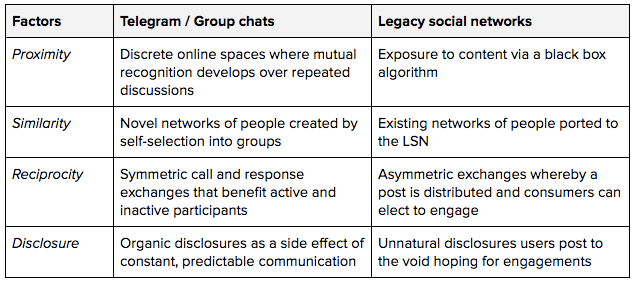Latest news about Bitcoin and all cryptocurrencies. Your daily crypto news habit.

Trust in large tech companies is cratering. Leading up to the #deletefacebook movement, Google and Apple saw their brand rank drop in the Harris Poll–a survey on the reputations of the most “visible” corporate brands (source). Meanwhile, Telegram, a group messaging app, crossed 200M monthly active users and is halfway through raising $2.5B+ in their token sale.
Ben Thompson covers what’s going wrong for these internet 2.0 giants in his latest post “The Facebook Brand.” So what’s going right for Telegram?
Many factors contribute to Telegram’s success like data encryption (though Telegram’s encryption is dubious), high performing UX, and an explosion of adoption from group like the blockchain community. But I’d like to focus on an explanation rooted in game design. Specifically, Daniel Cooks’ “Game design patterns for building friendships.”
He explains:
To build friendships, your game should facilitate four key factors. When these factors are present, friendships tend to form.Proximity: Put players in serendipitous situations where they regularly encounter other players. Allow them to recognize one another across multiple play sessions.Similarity: Create shared identities, values, contexts, and goals that ease alignment and connection.Reciprocity: Enable exchanges (not necessarily material) that are bi-directional with benefits to both parties. With repetition, this builds relationships.Disclosure: Further grow trust in the relationship through disclosing vulnerability, testing boundaries, etc.
Group chat apps (and Telegram in particular) outperform on these key factors.
- Proximity: Users enter an online room where mutual recognition develops across multiple discussions
- Similarity: Members in a group chat are curated by a shared reason for being in the group, guaranteeing some level of similarity
- Reciprocity: Exchanges are largely call and response. Someone asks a question, someone helps with an answer. Participation by individual members benefit the group
- Disclosure: People naturally open up and test boundaries as a side effect of the constant communication
Compare these dynamics to those of a legacy social network (LSN) where the primary interactions are posting content, viewing a feed of content, and engaging with content on the feed (e.g. comments, likes).
In a LSN, Proximity and Similarity (what shows up on your feed) are determined by a black box algorithm that optimizes for outcomes that are advantageous to the LSN, but not necessarily for the users. Reciprocity is asymmetric: there’s a poster and a engager. The poster looks for engagement and the engager most frequently interacts through mostly meaningless abstractions of engagement (e.g. a like). Finally, the LSN is a poor environment for Disclosure because of the poor Proximity, Similarity, and Reciprocity. Disclosures (e.g. sharing a vulnerable thought in a post) are aberrant and awkward because of their context (the feed that has nothing to do with their disclosure).
The LSN takes your existing friend graph and tries to incentivize engagements to benefit LSN data aggregation, the group chat app creates a place to serendipitously share exchanges with similar people. The physics of the group chat app are better for the user.
Are group chat apps perfect? Of course not.
Group chats lack algorithmic content curation. Without curation, user experience nightmares can arise like too much content (a spammy chat group), off-topic content, and not enough content (an inactive group). Bots, third party applications that run inside of Telegram, can help with these problems.
These apps also face the same data custody risk (misuse of user data) as LSN. Anxiety around China spying on WeChat conversations is the best example of this risk. The key is in the incentives of the app developer. If growth of their app requires monetization of user data (like LSNs), eventually their product decisions will lead to an app that conflicts with user interests. I wrote about this anti-user trend–and the promise of the decentralized web–in “Internet 3.0 and the demise of state aggregators.”
In short, the natural design of a group chat is better suited for social exchanges and making friends. The natural design of the LSN is better suited for delivering a feed of content. Both types of apps have data custody risk, though the negative impact of poor data custody is more readily apparent in LSNs.
Environments like group chats feel like an important part of our future and decentralization offers a path to scaling group chat apps while aligning the incentives of devs and users. The question is if users will demand it before it’s too late this time.
Thanks to Juyan Azhang for reading early drafts
Originally published at www.tonysheng.com on March 27, 2018.
Telegram’s design tailwind was originally published in Hacker Noon on Medium, where people are continuing the conversation by highlighting and responding to this story.
Disclaimer
The views and opinions expressed in this article are solely those of the authors and do not reflect the views of Bitcoin Insider. Every investment and trading move involves risk - this is especially true for cryptocurrencies given their volatility. We strongly advise our readers to conduct their own research when making a decision.
